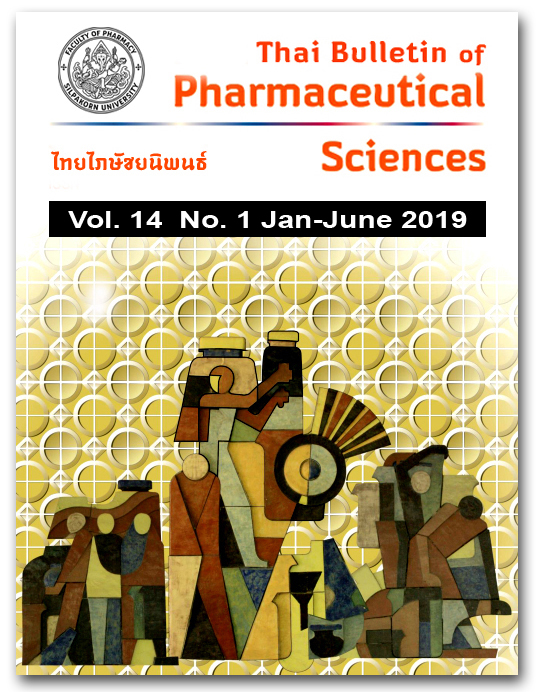AN APPLICATION OF TLC-IMAGE ANALYSIS FOR INVESTIGATION OF AQUEOUS EXTRACT OF COMMON CULINARY HERBAL COMBINATION, KAFFIR LIME LEAF, GALANGAL AND LEMON GRASS RHIZOMES
DOI:
https://doi.org/10.14456/tbps.2019.3Keywords:
TLC-image analysis, kaffir lime leaf, galangal rhizome, lemon grass rhizome, fingerprintAbstract
Kaffir lime leaf, galangal, and lemon grass rhizomes are ones of the common kitchen herbs used as flavoring ingredients in famous traditional Thai cuisine, called TomYum. These herbs are also employed as herbal medicines for a wide range of applications. A number of studies were conducted to investigate phytochemical constituents of these household remedy, however, the gas chromatographic (GC) and high performance liquid chromatographic (HPLC) analyses of volatile oils or essential oils in each individual herbal extract prepared by low to partial polar organic solvents were mainly focused. Since combinations of these herbs are usually prepared by brewing with hot water, therefore, this study presented the use of TLC-image analysis method for visualization of all detectable constituents in the aqueous extract of the multi-ingredient preparation. Good chromatographic separations of various substance classes were achieved on silica gel 60 F254S TLC plates with the use of several mobile phase compositions, multiple detections and TLC-image analysis software, Sorbfil TLC Videodensitometer, to create a chromatographic profile.
References
2. Ekpenyong CE, Akpan EE, Daniel NE. Phytochemical constituents, therapeutic applications and toxicological profile of Cymbopogon citratus stapf (dc) leaf extract. J Pharmacogn Phytochem. 2014;3(1):133-41.
3. Chudiwal AK, Jain DP, Somani RS. Alpinia galangal Willd. An overview on phyto-pharmacological properties. Ind J Nat Resour. 2010;1(2):143-49.
4. Jirovetz1 L, Buchbauer G, Shafi MP, Leela NK. Analysis of the essential oils of the leaves, stems, rhizomes and roots of the medicinal plant Alpinia galanga from southern India. Acta Pharm. 2003;53:73–81.
5. Phanthong P, Lomarat P, Chomnawang MT, Bunyapraphatsara N. Antibacterial activity of essential oils and their active components from Thai spices against foodborne pathogens. Science Asia. 2013;39:472–76.
6. Negrelle RRB, Gomes EC. Cymbopogon citratus (DC.) Stapf: chemical composition and biological activities. Rev Bras Plantas Med. 2007;9(1):80-92.
7. Verma RK, Mishra G, Singh P, Jha KK, Khosa RL. Alpinia galanga – An important medicinal plant: a review. Der Pharmacia Sinica 2011;2(1):142-54.
8. Kaushik D, Yadav J, Kaushik P, Sacher D, Rani R. Current pharmacological and phytochemical studies of the plant Alpinia galanga. J Chin Integr Med. 2011;9(10):1061-5.
9. Butryee C, Sungpuag P, Chitchumroonchockchai C. Effect of processing on the flavonoid content and antioxidant capacity of Citrus hystrix leaf. Int J Food Sci Nutr. 2009;60(S2):162-74.
10. Sidibe L, Chalchat JC, Garry RP, Lacombe L. Aromatic plants of Mali (IV): chemical composition of essential oils of Cymbopogon citratus (DC) Stapf and C. giganfeus (Hochst.) Chiov. J Essent Oil Res. 2001;13(2):110-2.
11. Barbosa LCA, Pereira UA, Martinazzo AP, Maltha CRA, Teixeira RR, Melo EC. Evaluation of the chemical composition of brazilian commercial Cymbopogon citratus (DC.) Stapf Samples. Molecules 2008;13(8):1864-74.
12. Bassolé IHN, Lamien-Meda A, Bayala B, Obame LC, Ilboudo AJ, Franz C, Novak J, Nebié RC, Dicko MH. Chemical composition and antimicrobial activity of Cymbopogon citratus and Cymbopogon giganteus essential oils alone and in combination. Phytomedicine 2011;18(12):1070–4.
13. Kasali AA, Oyedeji AO, Ashilokun AO. Volatile leaf oil constituents of Cymbopogon citratus (DC) Stapf. Flavour Fragr. J. 2001;16(5):377–78.
14. Rauber CS, Guterres SS, Schapoval EES. LC determination of citral in Cymbopogon citratus volatile oil. J Pharm Biomed Anal. 2005;37(3):597–601.
15. Mallavarapu GR, Rao L, Ramesh S, Dimri BP, Rao BRR, Kaul PN, Bhattacharya AK. Composition of the volatile oils of Alpinia galanga rhizomes and leaves from India. J Essent Oil Res. 2002;14(6):397-9.
16. Waikedre J, Dugay A, Barrachina I, Herrenknecht C, CabalionP, Fournet A. Chemical composition and antimicrobial activity of the essential oils from new caledonian Citrus macroptera and Citrus hystrix. Chem. Biodivers. 2010;7(4):871-7.
17. Roowi S, Crozier A. Flavonoids in tropical Citrus species. J Agric Food Chem. 2011;59(22),12217–25
18. Nicoletti M, Toniolo C, Gallo FR, Multari G, Polazzino G. Traceability in multi-ingredient botanicals by HPTLC fingerprint approach. J Planar Chromatogr. 2013;26(3):243-47.
19. Reich E, Schibli A. High-performance thin-layer chromatography for the analysis of medicinal plants. New York: Thieme Medical Publishers, 2006; p.129-214.
Downloads
Published
Issue
Section
License
All articles published and information contained in this journal such as text, graphics, logos and images is copyrighted by and proprietary to the Thai Bulletin of Pharmaceutical Sciences, and may not be reproduced in whole or in part by persons, organizations, or corporations other than the Thai Bulletin of Pharmaceutical Sciences and the authors without prior written permission.


